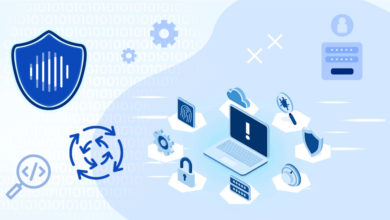
Transforming Network Security for the Digital Age with SASE
Transforming network security for the digital age with SASE is no longer a futuristic concept; it’s a necessity. The rise of cloud computing, remote work, and increasingly sophisticated cyber threats has rendered traditional network security models inadequate. SASE, or Secure Access Service Edge, offers a comprehensive, cloud-native approach that integrates security and networking functions to protect organizations in this ever-evolving digital landscape.
This post delves into the core components of SASE, its advantages over legacy systems, and how it’s reshaping the future of cybersecurity.
We’ll explore the challenges of securing remote workforces and cloud environments, examining how SASE effectively mitigates these risks. We’ll also discuss the crucial role of Zero Trust security within the SASE framework, showcasing its ability to enhance protection and streamline access control. Through practical examples and insightful analysis, we aim to provide a clear understanding of how SASE can bolster your organization’s security posture and prepare you for the challenges ahead.
Defining SASE in the Context of Modern Network Security
The digital landscape has fundamentally shifted, with employees accessing corporate resources from anywhere, anytime. This dramatic increase in remote work and cloud adoption has rendered traditional network security architectures obsolete and vulnerable. Enter Secure Access Service Edge (SASE), a cloud-native architecture designed to address the security and performance challenges of this new era. It’s a convergence of networking and security, delivered as a cloud service, providing a secure and optimized access experience for users regardless of location.SASE represents a paradigm shift from the perimeter-based security models of the past.
Securing our increasingly complex digital world demands innovative solutions, and SASE is leading the charge. But robust security needs equally robust application development to support it, which is why understanding the evolution of app building, as explored in this insightful article on domino app dev the low code and pro code future , is crucial. Ultimately, secure and efficient apps are key to a truly effective SASE implementation, protecting our data in the digital age.
Instead of relying on firewalls and VPNs situated at the edge of a network, SASE distributes security functions closer to the user and the cloud resources they access. This approach significantly improves performance and enhances security posture.
Core Components of SASE Architecture
SASE architecture is built upon a set of integrated security and networking services delivered as a cloud service. These core components work in concert to provide comprehensive protection and optimized connectivity. Key components include:
- Secure Web Gateway (SWG): Filters and inspects web traffic, protecting against malware and malicious websites.
- Cloud Access Security Broker (CASB): Provides visibility and control over cloud applications and data, ensuring compliance and preventing data breaches.
- Zero Trust Network Access (ZTNA): Grants access to resources based on identity and context, minimizing the attack surface.
- Software-Defined Perimeter (SDP): Creates secure connections between users and applications, hiding internal network infrastructure from unauthorized access.
- Firewall as a Service (FWaaS): Provides stateful inspection and protection against network-based threats.
- Data Loss Prevention (DLP): Prevents sensitive data from leaving the organization’s control.
These components are seamlessly integrated and managed through a centralized control plane, offering a unified security policy and simplified management.
SASE vs. Traditional Network Security Approaches
Traditional network security relies heavily on on-premises infrastructure, such as firewalls, VPNs, and intrusion detection systems. This approach is inflexible, difficult to scale, and struggles to keep pace with the ever-evolving threat landscape. SASE, on the other hand, offers several key advantages:
- Improved Performance: By distributing security functions closer to the user, SASE reduces latency and improves application performance.
- Enhanced Security: SASE’s integrated security services provide comprehensive protection against a wider range of threats.
- Increased Agility and Scalability: Cloud-based architecture allows for easy scaling and adaptation to changing business needs.
- Simplified Management: Centralized management simplifies security operations and reduces administrative overhead.
- Better Visibility and Control: SASE provides greater visibility into network traffic and user activity, enabling better control over security posture.
Examples of Successful SASE Implementations
While specific details of SASE implementations are often kept confidential for security reasons, several large organizations have publicly acknowledged their adoption of SASE principles. For instance, many Fortune 500 companies in the financial services and healthcare sectors are leveraging SASE to secure their increasingly distributed workforces and cloud-based applications. These organizations are benefiting from improved security, performance, and operational efficiency.
It’s important to note that the specific vendors and services used vary depending on the organization’s unique requirements.
Comparison of SASE and Traditional VPNs
| Feature | SASE | Traditional VPN |
|---|---|---|
| Security Services | Integrated SWG, CASB, ZTNA, FWaaS, DLP, etc. | Basic encryption and access control |
| Deployment | Cloud-based | On-premises or hybrid |
| Scalability | Highly scalable | Limited scalability |
| Performance | Optimized for cloud access | Can experience latency issues |
Addressing the Challenges of the Digital Age with SASE: Transforming Network Security For The Digital Age With Sase
The digital age has ushered in an era of unprecedented connectivity, but this interconnectedness has also significantly expanded the attack surface for cybercriminals. The sheer volume and sophistication of cyber threats are constantly evolving, demanding a more agile and comprehensive security approach than traditional network security solutions can offer. SASE, or Secure Access Service Edge, emerges as a powerful solution to address these challenges by integrating network security functions into a cloud-delivered service.
The Evolving Threat Landscape and its Impact on Network Security
The threat landscape is a dynamic battlefield. We’re seeing a dramatic rise in sophisticated attacks like ransomware, phishing, and advanced persistent threats (APTs). These attacks often leverage vulnerabilities in legacy network infrastructure, exploiting weaknesses in perimeter-based security models. The increasing prevalence of cloud services and the rise of remote workforces further complicate the situation, creating a distributed and often unmanaged attack surface.
The impact is significant: data breaches lead to financial losses, reputational damage, regulatory penalties, and disruption of business operations. The speed and scale at which these attacks can unfold necessitate a proactive and adaptive security strategy.
Securing Remote Workforces in a SASE Context
Securing a remote workforce presents unique challenges. Traditional VPNs, while offering some protection, often lack the granular control and visibility needed to effectively manage security risks across a distributed environment. SASE addresses this by providing secure access to corporate resources from anywhere, regardless of location or device. This includes consistent security policy enforcement, regardless of the user’s location or the network they’re connecting through.
Centralized management and monitoring capabilities offer enhanced visibility and control over user activity, allowing security teams to quickly identify and respond to threats. Furthermore, SASE’s integration of security and networking functions simplifies deployment and management, making it easier to secure remote workers without adding complexity.
Key Security Risks Associated with Cloud Adoption and SASE Mitigation
The shift to cloud computing offers significant benefits, but it also introduces new security risks. Data breaches, misconfigurations, and lack of visibility into cloud environments are common concerns. SASE mitigates these risks by providing consistent security policies across both on-premises and cloud environments. Its cloud-native architecture allows for seamless integration with cloud services, providing granular control over access and data protection.
Features like cloud access security broker (CASB) capabilities ensure secure access to cloud applications, while zero trust network access (ZTNA) prevents unauthorized access to sensitive data, regardless of location or device. This integrated approach offers a unified security posture across the entire digital landscape.
Hypothetical Scenario: A Security Breach and SASE Prevention
Imagine a fictional company, “GlobalTech,” with employees working remotely across multiple locations. A phishing email targets a remote employee, leading to malware infection on their laptop. In a traditional security setup, this could lead to a widespread breach, as the infected device could access internal networks and sensitive data. However, with SASE in place, several layers of protection would have mitigated this risk.
The SASE platform’s advanced threat protection would have identified and blocked the malicious email before it reached the employee’s inbox. Even if the malware bypassed initial defenses, the ZTNA capabilities would have prevented the infected device from accessing sensitive internal resources, limiting the impact of the breach. Finally, the centralized logging and monitoring capabilities would have alerted security teams to the suspicious activity, allowing for a swift and effective response.
The combination of these features ensures a robust defense against various attack vectors.
Key SASE Features and Their Implementation

SASE, or Secure Access Service Edge, isn’t just a buzzword; it’s a fundamental shift in how we approach network security. Its effectiveness hinges on the seamless integration and efficient operation of several key features. Understanding these features and their implementation is crucial for successfully adopting a SASE architecture. This section delves into the core components and provides practical guidance on their deployment.
The Role of Cloud Access Security Brokers (CASBs) in a SASE Architecture
CASBs act as the gatekeepers for cloud applications, ensuring secure access and data protection. Within a SASE framework, CASBs extend their functionality beyond simple access control. They integrate with other SASE components, providing comprehensive visibility and control over user activity across various cloud environments, both SaaS and IaaS. For example, a CASB can monitor user behavior in Salesforce, identify risky actions, and enforce data loss prevention (DLP) policies, all while maintaining a seamless user experience.
This granular control minimizes the risk of data breaches and ensures compliance with regulatory requirements. The integration of CASBs into the SASE architecture offers a unified security posture, streamlining management and enhancing overall security.
The Importance of Secure Web Gateways (SWGs) in a SASE Environment
Secure Web Gateways (SWGs) are critical for inspecting and filtering web traffic, protecting users from malware and malicious websites. In a SASE architecture, SWGs are strategically positioned to inspect traffic regardless of user location or device, providing consistent protection. Unlike traditional on-premises SWGs, SASE-based SWGs leverage cloud-native capabilities for scalability and performance. They can analyze traffic patterns, identify threats, and apply security policies dynamically, adapting to evolving threats in real time.
For instance, a SASE-based SWG can detect and block phishing attempts targeting employees accessing corporate resources from their personal devices, regardless of their geographic location. This ensures consistent security regardless of the user’s access point.
Best Practices for Deploying and Managing SASE Solutions
Successfully deploying and managing a SASE solution requires careful planning and execution. Key best practices include a phased approach, starting with a proof-of-concept (POC) to test functionality and identify potential challenges. Thorough integration testing with existing security infrastructure is also essential. Continuous monitoring and logging are vital for identifying and responding to security incidents. Furthermore, selecting a SASE vendor with a proven track record and strong support capabilities is crucial for long-term success.
Regular security audits and updates are essential to maintain the effectiveness of the SASE solution and adapt to the ever-evolving threat landscape. A well-defined incident response plan is also necessary to ensure swift and effective remediation in case of a security breach.
Migrating from Traditional Network Security Infrastructure to SASE: A Step-by-Step Guide
Migrating to SASE is a journey, not a single event. A phased approach is recommended.
- Assessment and Planning: Conduct a thorough assessment of your current network security infrastructure, identifying gaps and areas for improvement. Define clear objectives and a phased migration plan.
- Proof-of-Concept (POC): Implement a POC to test the chosen SASE solution in a controlled environment. This allows for validation of functionality and identification of potential issues before full-scale deployment.
- Pilot Deployment: Deploy the SASE solution to a small group of users or departments. This provides valuable real-world experience and allows for fine-tuning of configurations before wider deployment.
- Phased Rollout: Gradually roll out the SASE solution to the rest of the organization, ensuring smooth transition and minimal disruption.
- Continuous Monitoring and Optimization: Continuously monitor the SASE solution’s performance and effectiveness. Regularly review and optimize configurations based on usage patterns and evolving security threats.
The Role of Zero Trust Security in a SASE Framework
SASE, or Secure Access Service Edge, fundamentally shifts the network security paradigm. However, its effectiveness is significantly amplified when integrated with a Zero Trust security model. Zero Trust, with its “never trust, always verify” philosophy, perfectly complements SASE’s cloud-native, distributed architecture, creating a robust and adaptable security posture for the modern digital landscape.Zero Trust principles enhance SASE by reinforcing the continuous verification of every user, device, and application attempting access to resources, regardless of location.
This eliminates the implicit trust inherent in traditional network security models, which often rely on broad network perimeters and internal network segmentation. By adopting a Zero Trust approach within a SASE architecture, organizations drastically reduce their attack surface and limit the potential impact of breaches.
Zero Trust Models and Their Suitability for SASE
Several Zero Trust models exist, each with its strengths and weaknesses concerning SASE implementation. The most common models include those focused on device posture, user identity, and risk-based access. A device posture model assesses the security configuration of devices before granting access. A user identity model focuses on strong authentication and authorization based on verified identities. A risk-based model evaluates multiple factors, including user behavior and device context, to dynamically adjust access privileges.
For SASE, a hybrid approach, combining elements of all three, often proves most effective. This allows for granular control and adaptability across various user access points and devices, a key advantage in the distributed environment enabled by SASE. For example, a sales representative accessing sensitive customer data from a public Wi-Fi network would face stricter verification than an employee accessing internal systems from a secure corporate network.
Zero Trust Security Controls within a SASE Environment
Implementing Zero Trust within a SASE framework involves leveraging several key security controls. These controls operate across the various SASE components, including secure web gateways (SWGs), cloud access security brokers (CASBs), and zero trust network access (ZTNA) solutions. Examples include multi-factor authentication (MFA) for all access attempts, continuous user and device monitoring, micro-segmentation of network resources, and granular access control policies based on context and risk assessment.
For instance, a CASB can enforce data loss prevention (DLP) policies to prevent sensitive data from leaving the corporate environment, regardless of the access point. ZTNA ensures that only authorized users and devices can access specific applications and resources, eliminating the need for broad network access.
Benefits of Integrating Zero Trust with SASE
Integrating Zero Trust with SASE provides numerous advantages, creating a highly secure and efficient network architecture.
- Reduced Attack Surface: By eliminating implicit trust, Zero Trust significantly reduces the attack surface, minimizing the potential impact of successful breaches.
- Improved Visibility and Control: Continuous monitoring and granular access control policies provide enhanced visibility into user and device activity, allowing for proactive threat detection and response.
- Enhanced Data Security: Strong data protection measures, such as data loss prevention (DLP) and encryption, ensure that sensitive data remains secure, even when accessed from unmanaged devices or networks.
- Simplified Security Management: Centralized security management capabilities simplify the administration of security policies and reduce the complexity of managing multiple security tools.
- Improved Compliance: The enhanced security posture offered by Zero Trust and SASE helps organizations meet various compliance requirements, such as GDPR and HIPAA.
- Increased Agility and Scalability: The cloud-native architecture of SASE, combined with the adaptable nature of Zero Trust, allows for easy scaling and adaptation to changing business needs.
SASE and the Future of Network Security
SASE, or Secure Access Service Edge, is rapidly evolving, driven by the ever-changing landscape of cybersecurity threats and technological advancements. Its future hinges on the integration of emerging trends and technologies, promising a more secure and agile network architecture for businesses of all sizes. This section explores the key factors shaping the future of network security within the SASE framework.
Emerging Trends and Technologies Impacting SASE Evolution
Several key trends are significantly impacting the evolution of SASE. The increasing adoption of cloud-native applications and the rise of remote work are driving the demand for secure, consistent access to resources regardless of location. Simultaneously, the sophistication of cyberattacks continues to escalate, necessitating more robust and adaptable security solutions. The integration of advanced technologies like 5G and edge computing is also playing a crucial role, enabling faster response times and improved security posture at the network’s edge.
Furthermore, the shift towards zero trust architecture is fundamentally reshaping SASE, promoting granular access control and continuous verification of user and device identities.
The Potential Impact of AI and Machine Learning on SASE Security
Artificial intelligence (AI) and machine learning (ML) are poised to revolutionize SASE security. AI-powered threat detection systems can analyze vast amounts of data in real-time, identifying and responding to threats far more efficiently than traditional methods. ML algorithms can learn from past attacks, improving their ability to predict and prevent future incidents. For example, an AI-powered system might detect anomalous user behavior, such as unusual login attempts from unfamiliar locations, and automatically block access to prevent a potential breach.
This proactive approach minimizes the impact of attacks and reduces the reliance on reactive security measures. Furthermore, AI can automate many security tasks, freeing up security personnel to focus on more strategic initiatives.
Predictions for the Future of Network Security in the Context of SASE Adoption
The widespread adoption of SASE is likely to lead to several significant changes in the network security landscape. We can expect a significant reduction in the reliance on traditional VPNs and firewalls, as SASE provides a more integrated and streamlined approach to security. The complexity of managing network security will decrease, as SASE simplifies security management through centralized control and automation.
Furthermore, the increased visibility and control offered by SASE will improve incident response times and reduce the overall impact of security breaches. For instance, imagine a scenario where a compromised device is automatically isolated by the SASE platform, preventing further damage before human intervention is even necessary. This level of automation is a key prediction for the future of network security powered by SASE.
Potential Challenges and Opportunities Associated with Widespread SASE Adoption, Transforming network security for the digital age with sase
While the benefits of SASE are substantial, its widespread adoption also presents several challenges. The complexity of integrating SASE with existing network infrastructure can be significant, requiring careful planning and execution. Furthermore, the cost of implementing and maintaining a SASE solution can be high, especially for smaller organizations. However, the long-term benefits of improved security and reduced operational costs often outweigh the initial investment.
The opportunities associated with SASE adoption include improved agility, scalability, and flexibility. Organizations can easily adapt their security posture to changing business needs, ensuring they remain protected in a dynamic environment. The potential for innovation in security technologies within the SASE framework is also immense, leading to the development of even more sophisticated and effective security solutions.
The successful adoption of SASE will depend on addressing these challenges while leveraging the opportunities it presents.
Illustrative Example: Securing a Remote Workforce with SASE

Let’s consider a fictional company, “GlobalCorp,” a multinational organization with employees scattered across various geographical locations – from bustling city centers to remote villages. Their workforce includes sales representatives working from home offices, engineers collaborating on projects from different countries, and developers accessing cloud-based resources around the clock. This dispersed workforce presents significant security challenges that traditional network security solutions struggle to address effectively.
SASE provides a comprehensive solution to secure GlobalCorp’s remote workforce. By leveraging cloud-delivered security services and network connectivity, SASE ensures secure access to company resources regardless of the employee’s location or device. The security posture remains consistent, regardless of whether an employee connects through a corporate VPN, a public Wi-Fi network, or their home internet connection.
Secure Access for Remote Employees
GlobalCorp implements a SASE architecture that integrates several key components to protect its data and applications. For instance, a cloud-based Secure Web Gateway (SWG) filters all web traffic, preventing employees from accessing malicious websites or downloading malware. A Cloud Access Security Broker (CASB) monitors and controls access to cloud applications, ensuring only authorized users can access sensitive data stored in the cloud.
Furthermore, a Zero Trust Network Access (ZTNA) solution verifies the identity and posture of each device and user before granting access to internal resources, regardless of location.
Software Defined Perimeter (SDP) technology is also employed, creating secure micro-tunnels for each employee’s connection. This approach isolates traffic from each user, preventing lateral movement of threats even if one device is compromised. Finally, a robust Security Information and Event Management (SIEM) system monitors all security events, providing real-time threat detection and incident response capabilities.
Data Flow and Security Controls
Imagine a GlobalCorp sales representative, Sarah, in London, attempting to access a company CRM application hosted in a cloud data center in the US. Her laptop initiates a connection. The connection first passes through the SASE platform’s SWG, where web traffic is inspected and malicious content is blocked. Next, the traffic is directed to the ZTNA component, which verifies Sarah’s identity and device posture using multi-factor authentication (MFA) and posture assessment.
Only after successful verification is a secure micro-tunnel established by the SDP, providing direct and encrypted access to the CRM application. The CASB continuously monitors her activity within the application, preventing unauthorized data downloads or actions. All these events are logged and monitored by the SIEM system. Any suspicious activity triggers alerts, allowing GlobalCorp’s security team to respond quickly and effectively.
This process can be visualized as follows:
Sarah’s Laptop (London) –(SWG)—> ZTNA –(SDP Secure Micro-Tunnel)—> CASB –(Cloud Data Center, US)—> CRM Application
The arrows represent the flow of data, while the components in between represent the security controls that are applied at each stage. This illustrates how SASE provides comprehensive security for remote users, regardless of their location or the type of network they are using.
Outcome Summary
In conclusion, the shift towards SASE represents a fundamental change in how we approach network security. By converging security and networking functions in a cloud-delivered architecture, SASE provides a scalable, flexible, and highly secure solution for the complexities of the modern digital world. Embracing SASE isn’t just about keeping up with the times; it’s about proactively safeguarding your organization’s valuable data and ensuring business continuity in an increasingly unpredictable threat landscape.
The future of network security is secure, agile, and cloud-centric – and that future is SASE.
FAQ Summary
What are the main benefits of migrating to SASE?
Improved security posture, simplified network management, enhanced scalability, better cost control, and improved user experience.
How does SASE differ from a traditional VPN?
SASE is cloud-delivered and integrates multiple security services (like SWGs, CASBs, etc.), while VPNs primarily focus on secure connectivity.
Is SASE suitable for small businesses?
Yes, SASE offers flexible and scalable solutions that can be tailored to businesses of all sizes.
What are the potential challenges in implementing SASE?
Integration complexities, vendor lock-in, and the need for skilled personnel to manage the system.
What is the cost of implementing SASE?
The cost varies greatly depending on the size of the organization, chosen features, and vendor. It’s best to get quotes from different providers.





